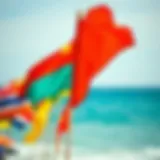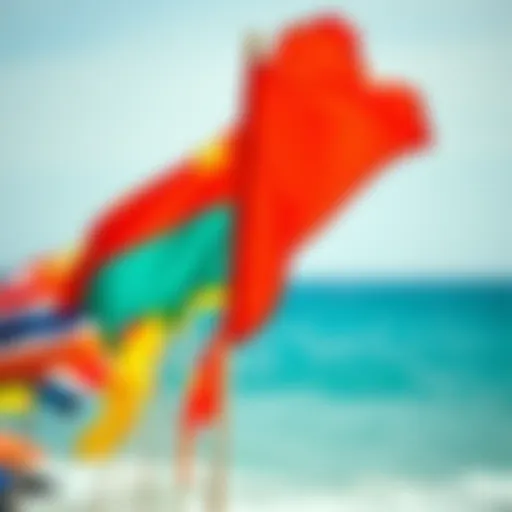North Shore Oahu Surf Report: Conditions & Insights
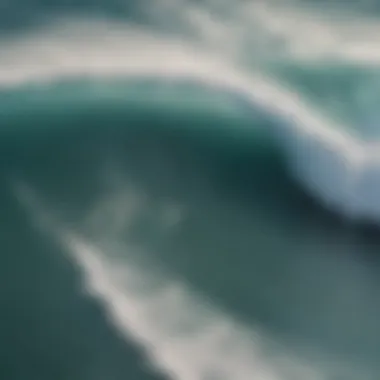

Intro
North Shore Oahu isn’t just a spot on the map; it’s a world-renowned surfing haven that draws enthusiasts and professionals alike. This legendary stretch of coastline offers more than just spectacular waves; it features a unique blend of culture, community, and environmental dynamics that influence surf conditions throughout the year. As surfers gear up for their next adrenaline-fueled adventure, understanding the nuances of this surf paradise becomes paramount.
Surf Gear and Equipment
To ride the waves effectively, equipping yourself with the right gear is essential. Surfboards, wetsuits, and accessories can make or break your experience on the water. Let's dive into what to look for.
Latest Surfboard Technologies
Surfboard design has evolved significantly over the years, with innovations that prioritize performance and durability. Modern surfboards often incorporate lightweight materials like epoxy, and their shapes are tailored to various conditions in North Shore.
- Hybrid Boards - These boards combine characteristics of shortboards and longboards, offering versatility for different wave types. They’re particularly good for adapting to the diverse conditions North Shore presents.
- Performance Shortboards - Ideal for experienced surfers, these boards help in carving tight turns and generating speed on steep drops. The responsiveness of a good shortboard is crucial, especially at spots like Pipeline.
- Soft-top Surfboards - Great for beginners, these boards are designed to provide more stability and reduce injury risks. They help new surfers focus on mastering their balance without the fear of sharp edges.
Essential Accessories for Surfers
Besides boards, having the right accessories can enhance your surf outings. Key items include:
- Wetsuits - Depending on the season, choose the right thickness for insulation against chilly waters.
- Leashes - A reliable leash is crucial. It keeps your board close and reduces potential hazards in crowded beach breaks.
- Surf Wax - This might seem trivial, but the right wax ensures proper grip on your board, especially during those wipeouts or big wipe-outs.
Techniques and Skills
Successful surf sessions demand not just the right gear, but also the proper techniques and respect for the ocean.
Wave Riding Strategies
Understanding wave dynamics is vital. Surfers should know when to paddle hard and when to conserve energy. Mastering the take-off, or the moment you hop up on the board, can be the difference between a thrilling ride and a face-full of water. Observing wave patterns beforehand can provide critical insights into where and how to position yourself.
Safety and Surf Etiquette
As with any sport, safety should not be compromised. Always keep an eye out for other surfers, and respect the rules of the ocean. Paddling out into the line-up without regard for others can lead to dangerous situations. Remember:
Surfing is as much about camaraderie as it is about riding waves. Respect the locals and adhere to surf etiquette.
Being aware of your surroundings, keeping a safe distance, and paddling with purpose are fundamental skills that every surfer should master.
The North Shore’s wave conditions can vary drastically depending on the season and weather patterns, so understanding and preparing for these changes can make all the difference. Surfers should continuously improve their skills while respecting both the ocean and the community surrounding this vibrant surf culture.
Overview of North Shore Oahu
Understanding the North Shore of Oahu is crucial for anyone looking to embrace the surfing lifestyle or simply enjoy the breathtaking scenery. This area is often heralded as the epicenter of surfing culture. It's not just about catching waves; the region's history, geography, and community all interweave to create an unparalleled surfing experience. From the iconic pipelines to the roaring winter swells, every aspect of North Shore plays a role in shaping the surfing landscape and the broader cultural significance of the sport.
Geographical Significance
The North Shore is a patchwork of stunning beaches, rocky outcrops, and lush vegetation. It stretches about 7 miles along the northern coast, with key beaches like Waimea Bay and Pipeline topping the list for surfers worldwide. The geographical layout of the shoreline creates unique wave conditions that vary throughout the year, making it a prime location for both novice surfers and seasoned pros.
The flow of ocean currents, combined with the arrangement of reefs and sandbars, results in some of the most powerful and challenging surf on the planet. Notably, these conditions attract both the American and international surfing populace, contributing to the area’s renown. Surfing here is about more than just the act of riding waves; it's about participating in a natural spectacle that is as exhilarating as it is humbling.
Just as importantly, the North Shore's proximity to other Hawaiian Islands establishes it as a vital point for tourists and surf travelers. Many flock here to experience the raw beauty of Oahu while looking to improve their surfing skills. Breathtaking cliffs provide panoramic views of the ocean, making it more than a spot for surf enthusiasts; it serves as a backdrop for countless adventure seekers.
Cultural Context of Surfing
Surfing on the North Shore transcends being merely a sport; it's an embodiment of a vibrant way of life deeply rooted in Hawaiian culture. The practice has been part of the Hawaiian identity for centuries, known historically as "he'e nalu." This ancient sport wasn't just for fun; it played a role in royal ceremonies and was part of the social fabric of communities.
Today, that cultural significance remains alive and well. The annual events, such as the Triple Crown of Surfing, showcase the skills of the best surfers while also paying homage to the sport's heritage. Local surfers often have an intrinsic respect for the ocean, guided by a sense of responsibility towards the water that feeds their passion.
Moreover, the diversity of the surf culture can be seen in the camaraderie among surfers from different backgrounds, who come together to share waves and foster friendships. It's common to hear stories of generations of families who surf together, passing down traditions and techniques that reflect their rich history.
As the sport evolves, modern surfers are also becoming advocates for ocean conservation, recognizing that their love for surfing equates to a responsibility for protecting the environment. Waves that have shaped the lives of many surfers must be treated with respect, a sentiment echoed by both locals and visitors alike.
"Surfing is not just about the ride. It's about the place and the people that have made it what it is today."
Surf Conditions in North Shore
Understanding the surf conditions in North Shore Oahu is crucial for anyone looking to catch the perfect wave. This area is known for its dramatic waves and consistent swell that draw surfers from around the globe. To truly engage with the experience of surfing, one must comprehend various aspects such as wave height, tidal movements, and wind patterns. These elements not only affect the quality of the surf but also play a significant role in a surfer's safety and enjoyment.
Current Wave Height and Quality
When it comes to wave height, North Shore delivers some of the most exhilarating conditions. During the winter months, surfers can find waves ranging from 10 to even 50 feet in height, especially at spots like Pipeline and Waimea Bay. The quality of these waves, characterized by their power and form, is often described as "world-class."
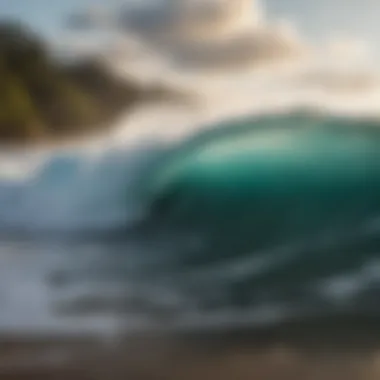

- Factors Influencing Wave Height:
- Seasonal swells, particularly during winter, are caused by storms in the North Pacific.
- Local wind conditions can either enhance or diminish wave quality.
Current reports on wave height can usually be accessed from various online surf forecasting platforms. Many of these resources, like Surfline or Magicseaweed, provide live updates about wave conditions to help surfers plan accordingly. Keep in mind, how a wave breaks can vary widely across different spots, influenced by underwater topography and swell direction.
Tide and Wind Patterns
Tides and wind play significant roles in shaping the surf conditions on North Shore. The tidal cycle typically consists of two high and two low tides each day, creating windows of optimal surf conditions. It's important to match your outing with the right tide. Many surfers have their own preferences:
- High Tide: Often results in a less powerful wave, but can be better for certain breaks like Sunset Beach.
- Low Tide: Generally provides more energy in the waves, creating steeper faces, although it can also expose more rocks and reefs.
Wind conditions are equally important. Offshore winds, blowing from the land to the sea, clean up the waves, resulting in clearer and better-shaping surf. On the contrary, onshore winds can muddle the waves, making them choppy and harder to ride.
Swell Direction Analysis
Swell direction is another key factor influencing the surf on North Shore. The primary direction of swells comes from the north-northwest, generating that iconic surf that attracts enthusiasts.
- Understanding Swell Directions:
- North-Northwest Swells are ideal for breaks like Pipeline and Ehukai.
- West Swells can also produce excellent conditions, especially at Waimea Bay.
As swells travel, their interaction with the ocean floor can change their behavior, producing different types of waves. The underwater landscape of North Shore, with its reefs and sandbars, further adds complexity to how swells behave when they reach the shore.
"The North Shore is like a symphony of nature; everything must come together—swell, wind, and tide—to create the perfect wave."
Surfers analyzing these elements will have a better understanding of when to hit the water and which spots to target. Keeping an eye on forecasting websites or even local surf reports can provide invaluable insights into current conditions.
In summary, grasping wave height, tide, and wind patterns alongside swell direction provides surfers with a well-rounded view of North Shore's surfing landscape. It allows one to thoughtfully plan their sessions and maximize the overall experience.
Popular Surf Spots
In the world of surfing, the North Shore of Oahu is often spoken of with reverence. Within this surfing sanctuary, there are distinct surf spots, each embodying unique characteristics, challenges, and allure that entice surfers from every corner of the globe. The significance of popular surf spots in this region goes beyond just being a place to catch waves; they are pivotal to the surfing culture, providing surfers with the thrill of the ride, community connection, and opportunity for skill development. Here, we delve into some of these iconic locations that deserve every surfer's attention.
Waimea Bay
Waimea Bay, a jewel on North Shore, is synonymous with big wave surfing. Known to reach monstrous heights in the winter months, this spot is a rite of passage for daring surfers looking to push their limits. The waves here are often considered both beautiful and dangerous, making them a perfect catalyst for adrenaline junkies.
The bay's unique geography also creates a pristine setting, framed by palm trees and volcanic rock. For those who aren't riding the waves, the bay offers stunning views and opportunities for snorkeling when conditions are mellow. It's crucial, however, to respect the power of the ocean here. As surfers say, "Respect the bay, or the bay will respect you back."
Pipeline
Pipeline is perhaps one of the most famous surf spots in the world. Its legendary waves, known for their heavy barrels, draw crowds of both spectators and surfers. This spot is more than just a surfing location; it’s a symbol of surf culture itself. At Pipeline, surfers face relentless waves that can give rise to thrilling rides or wipeouts that leave onlookers in awe.
The best time to surf here is during the winter months when the North Pacific storms generate powerful swells. Surfers must hone their skills, as the wave barreling over shallow reef can lead to serious injuries if not handled with care.
The atmosphere here is lively, filled with camaraderie as local and visiting surfers share the water, often accompanied by the rhythmic beats of island music playing from the nearby beach. It's a place where legends are born, but caution is prudent, as not all who surf Pipeline leave unscathed.
Sunset Beach
Sunset Beach is another gem in the North Shore lineup, known for its stunning sunsets that captivate every visitor. It features a more laid-back vibe compared to its neighboring breaks, making it appealing to a diverse range of surfers, from beginners to seasoned pros. The waves here tend to vary in size; however, during the winter, it can become a thrilling spot for larger swells similar to those at Waimea Bay.
This location is crucial for timing as well, as local contests often unfold here, highlighting the spirit of competition and the dedication of surfers. When conditions are right, Sunset Beach hosts some of the most mesmerizing back-to-back waves where surfers can ride for hundreds of meters. On calmer days, the beach draws families and beachgoers looking to soak up the sun and enjoy the ocean's beauty.
Laniakea Beach
Laniakea Beach, fondly referred to as "Turtle Beach," is famous for more than just its surf. The spot is also a natural habitat for Hawaiian green sea turtles, offering a unique experience for both surfers and beachcombers. Surfing here provides a tranquil atmosphere, showcasing smaller waves that are perfect for learning and practicing techniques.
However, many surfers find themselves drawn to the fun, playful conditions that occasionally produce decent swells, keeping them alert. The community surrounding Laniakea fosters a sense of connection among surfers, emphasizing respect for the ocean and its creatures. Laniakea’s beauty and charm encapsulate a different side of the surfing experience, one that entwines respect for nature with the thrill of the surf.
"Each wave tells a story, and each surf spot has a heartbeat that resonates with the surfers who know it well."
In summary, these popular surf spots on North Shore Oahu are not merely locations but vital cogs in the surfing narrative. From the adrenaline-pumping waves of Pipeline to the serene environment of Laniakea, they reflect a diverse surfing tapestry that beckons with unique allure and soul. For those eager to experience the North Shore, each spot offers an individual journey, filled with excitement, challenge, and connection to both nature and community.
Seasonal Patterns in Surfing
Understanding the seasonal patterns in surfing at North Shore Oahu is crucial for anyone who wants to ride those iconic waves. Each season brings distinct conditions, which can greatly influence the surfing experience. For surfers, knowing when to hit the water can mean the difference between an exhilarating ride and a frustrating session. This section dives into the two main seasons, detailing how winter and summer conditions differ, and what these variations mean for surfers.
Winter Swells and Their Impact
When winter rolls around, surfers on the North Shore eagerly await the arrival of sizable swells. Typically, from November through February, winter swells bring powerful, consistent waves that can reach staggering heights, often exceeding 20 feet. These swells are generated by storms in the North Pacific, allowing the surf to reach its peak.
The impact of these winter swells is not just in the size of the waves, but in the skill level of surfers they attract. Experienced surfers thrive during this time, as the impressive wave formations create the ideal backdrop for jaw-dropping maneuvers. However, let’s not kid ourselves, with great power comes great responsibility. Safety is paramount during this season. Newcomers should tread carefully; it’s a time best suited for seasoned surfers equipped with the right skills and gear.
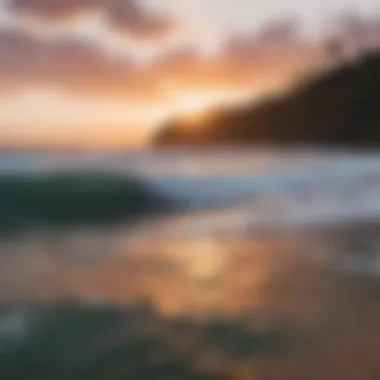

- Key Considerations for Winter Surfing:
- Wave Height: Expect big, unpredictable waves.
- Water Temperature: The waters can get chilly, so proper wetsuits are necessary.
- Crowd Factor: Popular spots are often crowded, making local knowledge invaluable.
In addition, watching for rip currents is especially critical when these swells are at their peak, as they can be fierce and potentially hazardous.
Summer Conditions and Variability
Summer brings about a contrasting scene on the North Shore. From May to September, the waves tend to shrink considerably, creating a whole new playground for surfers. This season is marked more by fun, social surfing rather than the heavy, intense sessions of winter. On most days, surfers can expect smaller wave heights of around 3 to 8 feet, ideal conditions for beginners and intermediates who want to sharpen their skills.
Additionally, summer conditions are not as consistent. Swell patterns can vary significantly, and a quiet day can sometimes turn into a delightful surprise with an unexpected swell appearing out of nowhere. The lighter winds can create glassy surfaces, perfect for those who relish a smooth ride.
- Highlights of Summer Surfing:
- Ideal for Beginners: Less intimidating waves can help build confidence.
- Local Events: Many surf competitions and festivals occur, making this a vibrant time on the coast.
- Changing Conditions: Be prepared for variations; having some flexibility in your plans can enhance your experience.
Whether it's summer or winter, recognizing and adjusting to seasonal patterns ensures that surfers can make the most of their time at North Shore Oahu. Understanding what each season has to offer, from gnarly winter swells to laid-back summer days, ultimately enriches not just individual skillsets but also the entire surfing culture on this legendary shore.
Weather Influences on Surfing
Weather influences play a crucial role in shaping the surf conditions at North Shore Oahu, the heartbeat for many surfers. Knowing how different weather patterns can affect surfing allows enthusiasts to time their visits and prepare for the best conditions. From tropical storms to gentle trade winds, every atmospheric element presents its own set of complexities that can either enhance or hinder a surfing experience.
Tropical Storm Effects
Tropical storms are not merely atmospheric disturbances; they serve as powerful generators of surf. When these storms brew in the Pacific, the energy they release can travel vast distances, manifesting as solid swells that hit North Shore with remarkable force. During storm events, surfers often flock to the island to chase the exhilarating waves that come in after the disturbance. But, it’s crucial to keep a few practical considerations in mind:
- Heavy Swells: Waves can quickly reach heights that are indeed awe-inspiring yet intimidating. The sheer power of these swells demands respect and attentiveness from anyone planning to surf them.
- Variable Conditions: The aftermath of a storm can lead to choppy waters or mixed swell direction, making it challenging to find the optimal spot for surfing.
- Safety Risks: Increased currents and hazardous debris can present dangers for even the most seasoned surfers. It’s essential to stay informed about local conditions when tropical storms are impacting the region.
"Timing is everything when it comes to riding the waves after a tropical storm; watch the shift and be ready as nature unleashes its raw power.”
Local Wind Patterns
Local wind patterns in North Shore are often overlooked, yet they are vital for determining wave quality. Trade winds predominantly blow from the northeast and can either complement the swell or create chaotic conditions. Here’s why wind should be on every surfer’s radar:
- Offshore Winds: These winds blow from the land towards the ocean and help to groom waves, resulting in clean, well-formed swells. They are prime for surfing and can dramatically improve the experience.
- Onshore Winds: In contrast, when winds blow from the ocean towards the shore, they can create choppy and unpredictable waves, adversely affecting surf conditions. Understanding daytime patterns can help surfers make informed decisions.
- Seasonal Variations: Wind patterns can shift with the seasons. Knowing the typical wind behavior throughout the year—be it calmer in the summer but strong in winter—can make or break a surf session.
The interplay between these weather influences becomes a dance of sorts, deeply integrated into the North Shore surfing culture. Surfers often consult both local meteorological data and more global weather forecasts to ensure they are catching the optimal conditions. Being aware of how tropical storms and wind patterns can affect the surf is half the game; it’s this knowledge that turns everyday sessions into unforgettable experiences.
Safety Considerations for Surfers
Surfing the North Shore is not just about catching waves; it’s an exhilarating experience that carries its risks. Understanding safety considerations while surfing is paramount for every enthusiast. This section emphasizes the significant aspects of safety for surfers to ensure a rewarding day at the beach.
Dealing with Rip Currents
One of the most critical hazards surfers face is rip currents. These strong, narrow channels of water flow away from the shore and can be treacherous. Knowing how to identify and react to them can be lifesaving. Rip currents usually form at low points or breaks in the sandbars and can be most dangerous at certain times, especially during high tide.
- Recognize the signs: Look for water that appears choppy, discolored, or has debris moving seaward. These visual cues often indicate a rip current.
- Stay calm: If caught in a rip current, it’s essential to remain composed. Panic can lead to exhaustion.
- Swim parallel to shore: Instead of fighting against the current, swim sideways to escape its grip. Once you are out of the current, you can make your way back to shore in safer waters.
"Knowing how to deal with rip currents can transform a potentially dangerous situation into a manageable one."
Educating yourself about local conditions and seeking guidance from seasoned surfers can offer invaluable insights. Each beach may have unique currents, so regular checking of the surf report before heading out is vital.
Understanding Local Etiquette
The surf culture on the North Shore encompasses not just the waves but also respect and camaraderie amongst surfers. Knowing local etiquette fosters a sense of community and enhances the surfing experience.
- Respect the line-up: Understanding your position in relation to others is crucial. Always give priority to the person closest to the peak of the wave. They’ve earned the right to ride it first.
- Communicate: A simple wave or shout can signal your intentions. Whether you’re paddling behind a surfer or taking off, clear communication avoids unnecessary collisions.
- Watch for locals: The North Shore has its share of well-established surfers. Being mindful and showing respect to them can facilitate goodwill and perhaps even some pointers.
Adapting to the local norms will not only help you gain acceptance but also make your surfing experience more enjoyable in the long run. By understanding these aspects of surfer safety, you can dive into the vibrant surf scene with confidence, ensuring that your time at the North Shore remains memorable for all the right reasons.
Gear Recommendations for North Shore
Whether you’re a fresh-faced grommet or a seasoned wave-rider, understanding the right gear for surfing North Shore is crucial. The unique climate, terrain, and oceanic conditions demand a thoughtful selection of equipment. Having the right boards, suits, and accessories not only enhances your performance but ensures your safety when dealing with the expansive swells that the North Shore is famous for.
Surfboard Selection and Maintenance
When it comes to surfboards, the robust lineup of choices can overwhelm even the most experienced surfers. You'll need to consider factors including shape, size, and materials.
- Shortboards are often the pick for advanced surfers aiming to conquer heavier waves at spots like Pipeline or Waimea Bay. Their agility allows for sharp turns, making it easier to navigate through intense conditions.
- Longboards, on the other hand, can be ideal for milder days. They provide stability and make catching smaller waves enjoyable. This option might appeal to beginners getting their feet wet.
- Fish boards are a hybrid choice, offering versatility for varying conditions. Their wider profile aids paddling and wave catching, particularly useful in summer months when conditions can get trickier.
Regardless of your selection, keeping your board well-maintained is non-negotiable. Regularly check for dings, wax as needed, and rinse it with fresh water after sessions. Keeping the board in shape prolongs its life and ensures you’re ready to ride without a hitch on those hefty North Shore waves.
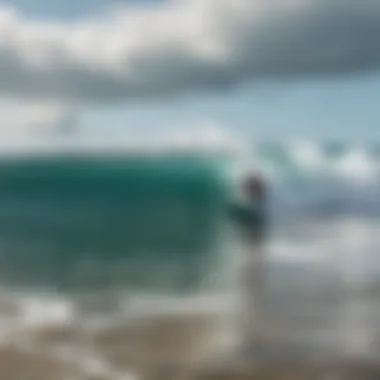

Wetsuits and Accessories
The waters of North Shore vary, but a good wetsuit is necessary virtually year-round. During the winter months, the ocean can chill down significantly, and surfers should have a thicker wetsuit, typically 4/3mm. As summer rolls in, the water is warmer, allowing for thinner suits, even springsuits or shorties if you’re brave enough.
- Key considerations when selecting a wetsuit:
- Fit: A snug fit is essential to prevent water from seeping in, yet avoid feeling like you’re in a vice grip.
- Material: Look for neoprene that boasts flexibility and warmth. Brands specializing in surf gear, like Rip Curl or O’Neill, often have good options that balance these aspects.
Accessories shouldn’t be an afterthought. You’ll want quality surf booties for grip — opting for those with a thin sole allows you to feel the board underfoot. Don’t forget about rash guards and lycra tops. Not only do they protect against sunburn, but they provide an extra layer against rashes when paddling.
Before hitting the waves, assess your gear carefully. A good ride often starts with quality equipment.
In the end, taking the time to choose wisely when it comes to surfboards and wetsuits enhances not only your performance but also your overall surfing experience on the bustling North Shore.
Environmental Impact and Conservation
Surfing is more than just a sport for many; it represents a lifestyle and an immersive connection to nature. As the surf culture flourishes on North Shore Oahu, there is an increasing need to acknowledge and address the environmental impact of both surf-related activities and broader ecological concerns. Conservation efforts here are crucial in preserving not only the surf experience but also the intricate balance of marine ecosystems, ensuring that future generations can enjoy the waves, the ocean, and the surrounding beauty.
Understanding Ocean Health
Ocean health is a multifaceted topic that encompasses various elements critical for sustaining marine life and, by extension, the sport of surfing itself. Healthy oceans contribute to better wave formation and quality, which surfers cherish. Pollutants, waste, and climate change threaten this delicate balance.
One impactful aspect is water quality. Surfers are just a few of the many stakeholders who advocate for keeping oceans clean. High levels of bacteria from runoff can lead to serious health concerns. Dirty water creates not just an unpleasant experience but poses risks like skin infections and gastrointestinal illnesses. Lack of awareness often leads to careless littering or failing to recycle, a behavior we need to flip on its head.
Key elements influencing ocean health include:
- Pollution: Chemicals and waste from land can flow into the ocean.
- Overfishing: It disrupts the food chain which can impact the aesthetic value of surf spots.
- Climate Change: Changes in temperature affect wave patterns and the coasts' ecosystem.
Initiatives for Ocean Preservation
To tackle the challenges facing ocean health, several initiatives have sprung up across North Shore Oahu that involve local communities, surfers, and environmental advocates alike. Being proactive about conservation ensures a thriving environment that’s not just ideal for surfing but also vital for marine biodiversity.
Several projects and programs focus on:
- Beach Clean-up Drives: Regularly scheduled events encourage local surfers and beachgoers to gather and remove trash and debris from the beaches. This not only improves the ocean's condition but also fosters a sense of community.
- Education and Awareness Campaigns: Workshops and programs designed to teach both locals and tourists about the ecological significance of marine systems conduct an essential service. Knowledge is power, and properly informing people can lead to more responsible behavior.
- Marine Protected Areas: Implementing zoning regulations restricts activities like fishing and development in critical habitats. This can help replenish fish populations, enhance biodiversity, and ultimately lead to better surfing conditions.
"A healthy ocean is a surfer's best friend; protecting it is our responsibility."
The Future of Surfing on the North Shore
As we look toward what lies ahead for surfing at North Shore, it’s crucial to grasp that this iconic surf destination is not just about riding waves. The future of surfing here encapsulates changing tides in technology, culture, and environmental consciousness. It grants surfers fresh ways to connect with the ocean and the community surrounding it. The evolution of this surf culture is intrinsically tied to both the advancements in technology and the ever-changing social landscape.
Technological Advancements in Surfing
The sheer pace of technological improvements impacting surfing is nothing short of remarkable. From ultra-light surfboards to smart wetsuits embedded with sensors that monitor body temperature and hydration levels, innovation has seeped into every aspect of surfing. Consider, for example, the introduction of drones. These enabling devices have become tools not only for helping lifeguards monitor conditions but also for surfers to capture breathtaking footage of their sessions.
With apps like Surfline, real-time wave forecasts and condition reports keep surfers informed. Not to mention, personalized coaching via virtual reality is slowly creeping into the mix. This technological shift isn’t merely about entertainment; it fosters a safety-first approach. Surfers can make more informed choices about when and where to hit the water, whether it’s dodging dangerous rip currents or searching for the perfect swell.
Greater emphasis is being placed on developing sustainable materials for surfboards too. Companies like Firewire are crafting boards with environmentally conscious designs. Using materials like recycled polystyrene foam and bio-resins could play an integral role in reducing the industry's overall carbon footprint.
Evolving Surf Culture
The surf culture at North Shore is in a continual state of flux. While it holds tightly to its roots, diversity is helping to shape its future. As people from various backgrounds, skill levels, and age groups take to the water, the conversations surrounding inclusiveness are gaining momentum. This cultural evolution offers a richer experience for all involved, whether they're seasoned pros or scraping their knees on their first attempt.
Art and music remain at the heart of this community. Artists are merging traditional Hawaiian influences with modern styles, encapsulating the essence of surfing through various mediums. You’ll often find exciting pop-up art shows on the beach or local gigs where surfers gather. This blend of art, lifestyle, and surfing fosters deeper connections and understanding among surfers, amplifying their experiences.
Moreover, as environmental awareness increases, surfers are becoming advocates for ocean preservation. Initiatives aimed at cleaning beaches or reducing single-use plastics are gaining traction, emphasizing that surfing extends beyond just the sport; it’s about protecting the playground we cherish. It's not uncommon to see groups with boardshorts fishing trash out of the ocean, shaping a narrative where every wave has its responsibility.
In summary, North Shore's surfing future isn’t merely a forecast for wave sizes; it embodies technological evolution, cultural diversity, and environmental accountability. As long as surfers are willing to embrace these changes, both the ocean and its community stand to gain.
End
The conclusion of this surf report for North Shore Oahu isn't just a wrap-up; it serves as the cornerstone for surfers looking to surf intelligently and safely. By synthesizing the key details surrounding wave conditions, gear requirements, and safety measures, this closing section enables surfers to make informed decisions. It pulls together the threads of information previously presented, showcasing the dynamic nature of surfing in this iconic destination.
In summary, recognizing the complex interplay of environmental factors is paramount. Surfers who grasp these elements can better anticipate the day’s conditions, thus enhancing both their performance and enjoyment in the water. The advice given here is not merely practical; it’s designed to instill confidence before paddling out into those famed North Shore waves.
Recaping Key Takeaways
- Wave Conditions: Understanding the daily variations in wave height, tide, and swell direction is crucial for determining when to hit the water.
- Safety First: Recognizing local surf etiquette and navigating rip currents is essential for a safe surfing experience.
- Gear Matters: Selecting the right surfboard and wetsuit can make a significant difference in performance.
- Respect for the Ocean: Engaging in conservation efforts is vital for maintaining the health of surf environments.
- Adaptability: Both seasonal changes and weather patterns can impact surf conditions—being adaptable is key for surfers.
"Surfing is an art form, but it demands respect for both the sport and the ocean."
Future Insights for Surfers
Looking ahead, the dynamics of surfing on North Shore will continue to evolve. Advances in technology are reshaping the gear surfers utilize, enhancing performance while maximizing safety. In particular, innovations in surfboard design and materials hint at a future where surfers can push the limits of their capabilities.
Moreover, as climate change increasingly influences ocean conditions, surfers must stay vigilant and informed. Engaging with local communities, attending workshops, and participating in ocean conservation initiatives not only fosters a deeper connection with the sport but also aids in preserving surf spots for future generations.






